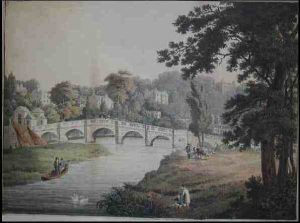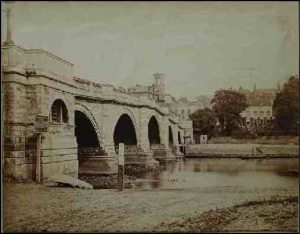Richmond Bridge – [Local History Notes: 7]
Long before Richmond Bridge was built, a ferry was operating at the site, that is from Ferry Hill (now Bridge Street) across to Twickenham Meadows. There were 2 boats: one for passengers and a much larger vessel, the ‘horse-boat’ for the conveyance of horses, small light carts and bulky goods. Carriages, however, could not be taken on the ferry.
In 1773, Mr Windham, the lessee of the ferry at that time, offered to sell the remainder of his lease to the Crown Commissioners for £6,000 and to use the money for the erection of a bridge. A petition was made to the House of Commons for leave to bring in a Bill.
The local inhabitants, though in favour of a bridge being built, were strongly opposed to Windham’s scheme. There were 3 main objections: to the Richmond site (Ferry Hill) which was inconvenient to access and had a very sharp declivity; to the proposed material for the structure – wood; and to the fact that the bridge would be privately owned.
This opposition led Windham to withdraw his Bill. Plans for a stone bridge, to be erected from Water Lane, were put in hand. The cost – £26,000 – was raised on Tontine shares of £100 each. (Under this system each shareholder received a proportion of the bridge tolls until his death, when his shares were added to those of the remaining shareholders. The Tontine could not lapse until the death of the last surviving shareholder).
Water Lane
Counter opposition was to follow, however: from the inhabitants of Water Lane who would have lost their homes in the necessary widening of the Lane; from the lessee of the “Feather Inn”, which would also have been demolished; and from the proprietor of Twickenham Farm, where the bridge would end on the Middlesex side of the river.
His Majesty’s Commissioners decided, therefore, that the bridge should, after all, be built from Ferry Hill and the Richmond Vestry had no alternative but to follow their decision.
 The foundation stone of Richmond Bridge was laid on 23 August 1774 by the Hon. Henry Hobart. The principal architect was James Paine (c.1716-1789), who was also responsible for the bridge at Kew (constructed 1783-89) which preceded the present one (built in 1903). In March 1758, Paine had been appointed Clerk of the Works at Richmond New Park Lodge. Earlier, in December 1746, he had been appointed Clerk of the Works at Charing Cross Mews – a position which he afterwards exchanged with Kenton Couse for the Clerkship of the Works at Newmarket. It was Couse (1721-1790) who assisted Paine in the building of Richmond Bridge.
The foundation stone of Richmond Bridge was laid on 23 August 1774 by the Hon. Henry Hobart. The principal architect was James Paine (c.1716-1789), who was also responsible for the bridge at Kew (constructed 1783-89) which preceded the present one (built in 1903). In March 1758, Paine had been appointed Clerk of the Works at Richmond New Park Lodge. Earlier, in December 1746, he had been appointed Clerk of the Works at Charing Cross Mews – a position which he afterwards exchanged with Kenton Couse for the Clerkship of the Works at Newmarket. It was Couse (1721-1790) who assisted Paine in the building of Richmond Bridge.
The bridge was completed in 1777. The London Magazine (1779) described it as:
‘a simple, yet elegant structure, and, from its happy situation,… one of the most beautiful ornaments of the river and the country adjacent. It is built with Portland stone from the design of Mr Payne [sic] of London, a celebrated architect, and the masonry was executed by Mr Carr of Richmond …’
In 1859, the last surviving Tontine shareholder died, so the tolls were discontinued.
The bridge was widened during 1937, and apart from being less ‘hump-backed’, its original appearance was cleverly preserved.
The tolls levied on the bridge were as follows:
| Every coach, chariot, landau, berlin or chase, drawn by 6 horses, ‘or other cattle’ | 2s 6d | |
| Vehicles drawn by only 4 horses | 1s 6d | |
| Vehicles drawn by less than 4 horses (or more than 1 horse or other beast) |
1s 1s 6d |
weekdays
Sundays |
| Vehicles drawn by 1 horse only |
8d 1s |
weekdays
Sundays |
| Commercial vehicles | ||
| Every waggon, wain, dray, car, cart or other carriage: | ||
| drawn by more than 6 horses | 2s | |
| drawn by more than 4, but less than six | 1s 6d | |
| drawn by 2 or 3 horses | 1s | |
| drawn by a single horse | 8d | |
| Every higler’s or baker’s cart drawn by 1 horse pr beast | 6d | |
| Every horse, mare, gelding, mule or ass, laden or unladen, and not drawing a vehicle | 2d | |
| Every foot passenger | 1/2d | |
| (if trundling a wheelbarrow ‘or such like carriage’) | 1d | |
| Cattle | 3s 4d a score | |
| Every drove of calves, hogs, sheep or lambs | 6d a score |
Footnote on old units of currency and measure
1s = 1 shilling = 5 pence in today’s decimal currency.
1d = 1 old penny. There were 12 pennies to a shilling. (The abbreviation d. comes from the Roman denarius).
A ‘score’ = 20.
Sources
Chancellor, E. Beresford / The history and antiquities of Richmond,Kew, Petersham, Ham etc.1894
Dunbar, Janet / A prospect of Richmond. Rev. ed. 1973
Nairn, Ian and Pevsner, Nikolaus / Surrey (The buildings of England). 1962
Richmond Bridge Commissioners’ Minute Book 1773-1786 (Manuscript)
A copy of River Crossings from Hampton to Hammersmith [Local History Note: 48] is available from the Local Studies Library and Archives along with more information about the places and people of interest in Richmond upon Thames.
More information on other historic sites in the London Borough of Richmond upon Thames is available from the Local Studies Library & Archive.
